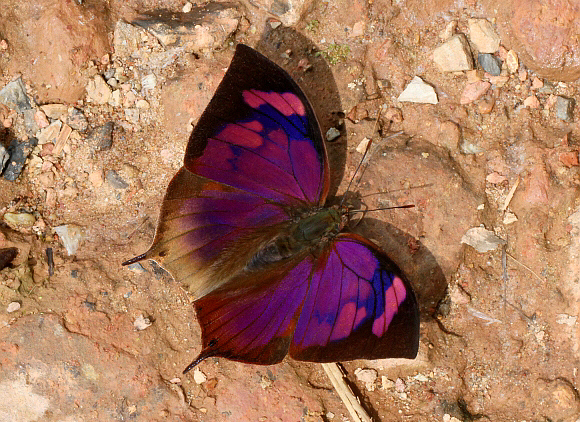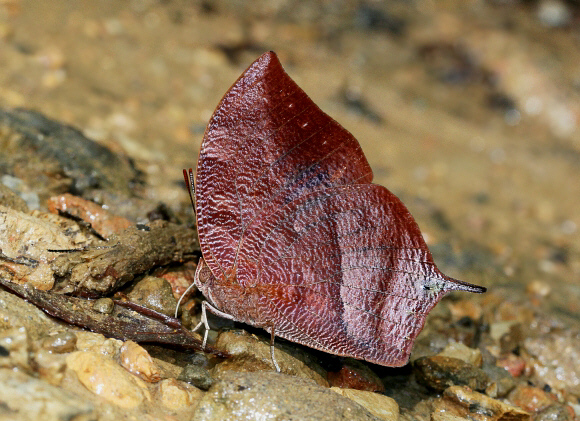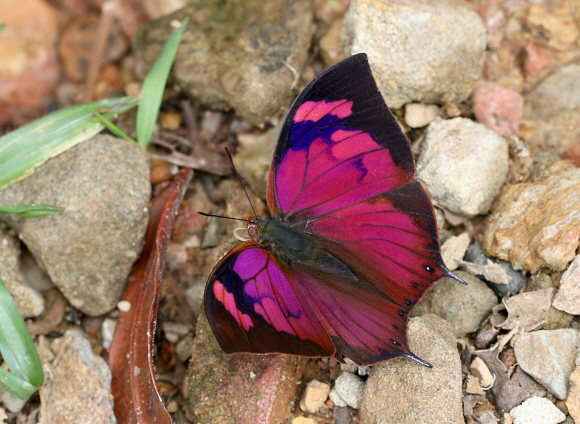 Fountainea nobilis pacifica, Tatama NP, Colombia – Adrian Hoskins
Fountainea nobilis pacifica, Tatama NP, Colombia – Adrian Hoskins
Introduction
The tribe Anaeini comprises of 87 neotropical species in the genera Coenophlebia, Consul, Anaea, Polygrapha, Memphis, Siderone, Fountainea and Zaretis. The butterflies are characterised by having a very rapid and strong flight. They have stout bodies, falcate wings, and on the upper surface are generally black, marked with bands of orange, bright red, or lustrous blue according to species. The undersides of all species in the Anaeini are cryptically patterned and bear a strong resemblance to the dead leaves, tree bark or boulders on which they settle.
The genus Fountainea comprises of 8 species, most of which are widely distributed throughout the neotropical region. The hindwings of most species have short tails, in both sexes, although in the males of ryphea and sosippus these are vestigial or absent.
Fountainea nobilis occurs as 6 subspecies variously distributed from Mexico to Peru. Males of most races are orange-brown on the upperside with only a subtle purple sheen, but the Colombian race pacifica is very beautiful, with an intense pinkish-purple sheen across the entire surface of both wings. The females are equally striking, being orange-brown marked with white or yellow.
 Fountainea nobilis pacifica, Tatama NP, Colombia – Adrian Hoskins
Fountainea nobilis pacifica, Tatama NP, Colombia – Adrian Hoskins
Habitats
Fountainea nobilis inhabits cloudforest at elevations between about 800-1800 metres.
Lifecycle
The lifecycle is probably similar to that of Fountainea halice, details of which are given below :
The eggs are white, and laid singly on the foliage of the foodplants. The fully grown larva is green, with paler longitudinal lines along the back, and lightly marbled with reddish brown and white along the sides. It has a large head that is adorned with a pair of short horns. The larva lives within a cell made by rolling up a leaf and securing it with fine silk. It feeds on saplings of Croton – a tree in the Euphorbiaceae. The chrysalis is suspended by the cremaster from a stem or leaf. It is pale greenish, with the wing cases edged in pale yellow. The head and thorax form a barrel shaped section, and the abdominal segments are highly compressed, forming a short cone.
Adult behaviour
Males are usually seen singly, either imbibing mineralised moisture from damp ground, or resting on tree foliage. They generally keep their wings closed when at rest, but in early morning or late afternoon when temperatures are low they can sometimes be seen basking.
The flight and general behaviour is similar to that of other Charaxine genera. They tend to remain settled either on foliage or on the ground for quite long periods. If disturbed they fly up, circle around briefly, and then settle on the foliage of a nearby tree. After a few minutes, when they feel safe, they descend in a series of steps, often settling in dappled sunlight.

Fountainea nobilis pacifica, Tatama NP, Colombia – Adrian Hoskins
